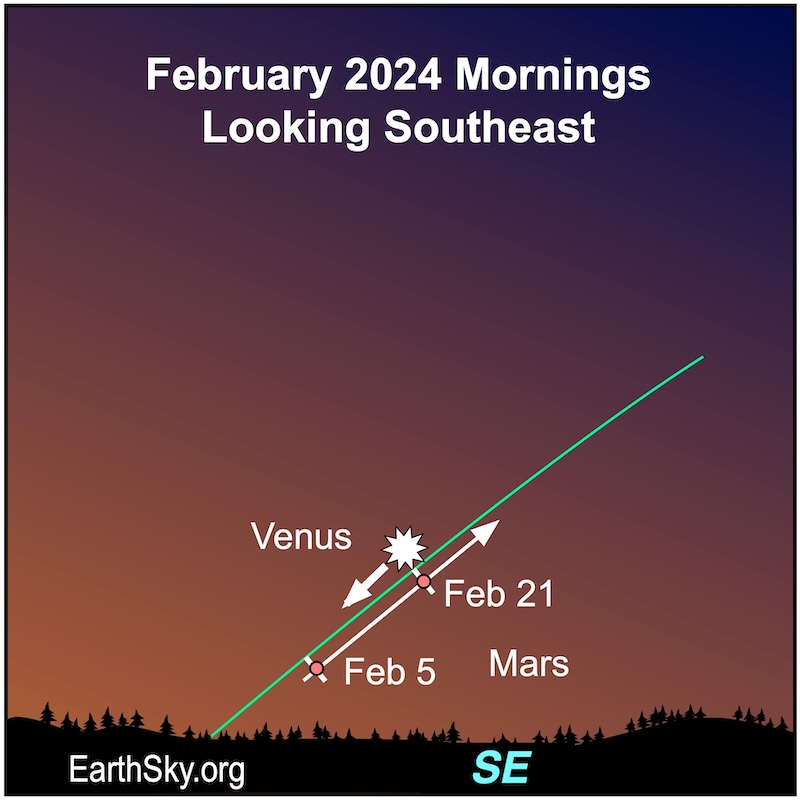[ Skywatchers ] [ Main Menu ]
47951

From: Eve, [DNS_Address]
Subject: Mars Back in the Morning Sky (+ Mars & Venus conjunction 2-22-24)
|
Mars & Venus in constellation Capricorn Earth in constellation Leo Sun in constellation Aquarius Mars in 2024: Back in the morning sky Image Caption: In the middle of February, Mars will move close to brilliant Venus. Theyíll be an interesting contrast in brightness, with Venus shining at magnitude -3.9 and Mars shining at +1.3. So Venus is roughly 100 times brighter than Mars. They will be at their closest on February 21 and 22, 2024. Then Venus will continue to descend closer to the sunrise each day, while Mars climbs out of the morning twilight. Chart via John Jardine Goss/ EarthSky. Mars can appear bright or faint in our sky. 2024 is mostly a faint year. Around February, Mars becomes visible in the east before dawn. Itís faint and far across the solar system from Earth. As the days pass, Mars will be climbing higher in the predawn sky, growing steadily brighter. Earth will be gaining on Mars, in our smaller, faster orbit around the sun. Around the September equinox, Mars will start becoming noticeable in our skies! By the yearís end, itíll shine brightly at -1.2 magnitude. Its next opposition will come in January 2025. Mars in 2024 Opposition for Mars last fell on December 8, 2022. Thatís when our planet Earth last flew between Mars and the sun. Itíll reach opposition again in January 2025. Now, in February 2024, Mars will be ascending in the morning sky. In fact, Mars will be visible in the morning sky all year. How to see Mars in the sky: In early February 2024, Mars will be low in the eastern morning sky and challenging to spot in the bright twilight. However, itíll become easier to spot by monthís end. Itíll be shining at magnitude +1.3. Constellations in February 2024: Mars, it would be crossing in front of the constellation Sagittarius and move in front of the constellation Capricornus the Sea-goat. Note: Mars reaches opposition about every 26 months, or about every two Earth-years. So Mars alternates between appearing bright and faint in our sky. It was bright in late 2022 and early 2023. But by September 2023, Mars faded dramatically in brightness and disappeared in the sunset glare in October 2023. It passed behind the sun on November 18. It came back into view, in the east before sunrise, at the end of 2023 shining around magnitude +1.4. ....more about Mars in 2024 + at link... |
Responses:
[47967]
47967
From: Eve, [DNS_Address]
Subject: Re: Mars Back in the Morning Sky (+ Mars & Venus conjunction 2-22-24)
|
Close approach of Venus and Mars This event is not observable at present from Austin. THU, 22 FEB 2024 AT 03:46 CST (09:46 UTC) 3 HOURS AWAY (from time of this post approx.) Dominic Ford, Editor From the Appulses feed The planets Venus and Mars will make a close approach, passing within a mere 37.4 arcminutes of each other. Venus will be at mag -3.9; and Mars will be at mag 1.3. Both objects will lie in the constellation Capricornus. They will be a little too widely separated to fit comfortably within the field of view of a telescope, but will be visible to the naked eye or through a pair of binoculars. At around the same time, the pair will also share the same right ascension Ė called a conjunction. A graph of the angular separation between Venus and Mars around the time of closest approach is available here. The positions of the pair at the moment of closest approach will be as follows: Object Right Ascension Declination Constellation Magnitude Angular Size Venus 20h37m00s 18į57'S Capricornus -3.9 11"3 Mars 20h37m20s 19į34'S Capricornus 1.3 4"1 |
Responses:
None
[ Skywatchers ] [ Main Menu ]